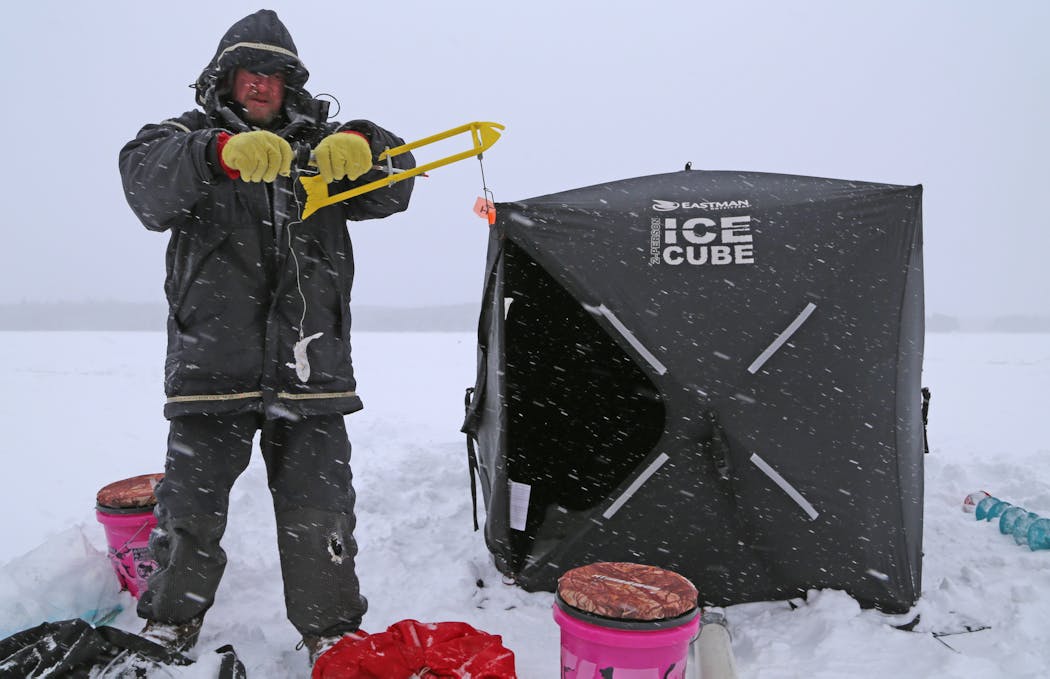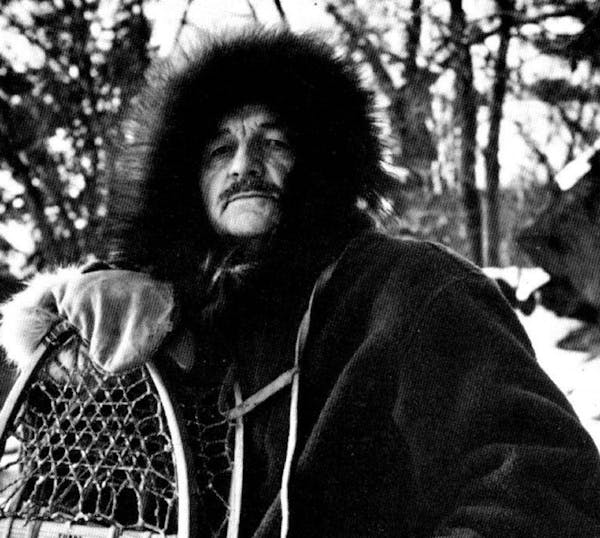BOUNDARY WATERS CANOE AREA WILDERNESS – On Tuesday while snow tumbled in waves across Basswood Lake, Stu McEntyre turned his back to a strong wind and fiddled with a tip-up. Along with his daughter, Shelby, we had driven three teams of dogs up Fall Lake and across Four Mile Portage to Basswood, a giant northern border water.
Throughout the 7-mile trip, the valiant animals that pulled our sleds struggled with deep drifts in the lake's open areas, and Stu, Shelby and I covered our eyes with our arms in attempts to block the blustering snow.
Stu is a friend from the days when I lived in Ely. We were younger then, and Stu, along with his friends and mentors Don and Val Beland, raced his dogs from Minnesota to Alaska and back.
Now for many years along with Shelby and his wife, Jeanne, and son, Spencer, Stu runs winter dog sled trips into the wilderness, often toting tourists who have never seen so vast an area that is so desolate and so quiet. And so cold.
"If you drill the holes, I'll get the baits ready," Stu said.
We had arrived 20 minutes earlier. This was a northern pike foray and therefore not a long trip. Often in winter Stu and I instead will vector deeper into the BWCA, to Knife Lake, a distance of about 17 miles, to fish for lake trout.
But along Minnesota's north country snow is piled deep this winter, and we would have had to break trail nearly the entire distance to fish for trout. So instead we came to Basswood for northerns.
With a shovel, I heaved knee-deep snow from a 4-by-4-foot patch of ice. Then, with a hand auger, I leaned into the business of boring a hole through 30 inches of hard water.
Shelby, meanwhile, tethered our 17 dogs nearer to shore, anchoring their traces with ice stakes and allowing the willing animals to curl tightly into themselves for warmth and rest.
"I've fished pike a few times this winter," Stu said, noting most of his clients want only to travel in the boundary waters in winter, not fish. "It's been OK, but not great."
Before regulations governing snowmobile travel in the BWCA were tightened in 1978, lakes along this stretch of the Minnesota-Ontario border received a fair bit of winter fishing pressure.
Trips on snowmobiles to Knife Lake from Ely for lake trout were commonplace. Also, using snowmobiles, my friends and I pulled sleds loaded with cross-country skis and camping gear up Moose, Newfound and Sucker lakes to Prairie Portage. There — exactly on the Minnesota-Canada border — we'd park the rigs and ski into adjoining Quetico Provincial Park for trout. Memorably, at night with our tents pitched beneath statuesque red and white pines, our campfires melted snow in ever-expanding concentricities.
I drilled four holes and soon each was fitted with a tip-up whose bright orange flag would stand erect if a fish chomped the large suckers we used for baits.
By then the dogs were quiet. Lying in a long row, snow gathered on their thick fur.
The morning was warm, 15 degrees or so. But the wind bent snow nearly horizontally across the broad white expanse.
"I'll heat up some soup," Stu said. "We've also got hot chocolate and cider."
Stu and I years ago occasionally saw a moose, or at least moose signs, on these trips. Then the big animals vanished. Perhaps four or five years ago on the way to Knife Lake in a ghostlike forest of sterile trees flooded by beavers, we crossed a set of moose tracks and were surprised to find them. But wildlife and even signs of wildlife generally are no-shows in these parts in winter, save for the occasional wolf or deer track or the even more rare otter track that connects two otherwise unseen open bodies of water.
Ravens are an exception. In Tuesday's wintry tempest, two of the big black birds struggled above us for purchase.
We had set up a portable fishing shelter to clamber into, if we wanted, to jig for northerns. But to keep the tip-ups in clear view we instead sat in the open on buckets with our backs to the wind while eating Jeanne's excellent corn chowder and gulping hot chocolate.
And waiting.
Flag.
Because we were fishing near shore in shallow water the run to the flag covered only 20 yards or so. On Knife Lake, where we might fish for trout in 100 feet of water and drill holes somewhat farther from shore, the trudge through snow to active tip-ups can be epic, and epically exhausting.
Reaching the standing flag, Stu watched line peel from the tip-up's spool into the watery darkness below.
"Spinning!" he yelled.
To be successful, winter anglers often must deploy finesse and a delicate touch, especially while fishing for northern pike, which beneath the ice can be lethargic and often take baits into their toothy mouths only to release them moments later.
Picking up the heavy line, Stu felt for resistance.
"He's there!"
Then he jerked the line upward, setting the hook.
Surely nothing about the world above the ice to which a northern pike weighing about 8 pounds was soon transported would have enticed the elongated fish to reject its home waters in favor of a land-based existence.
Nor did Stu offer that opportunity. Instead, head first, the fish was soon returned to the cold water, its gently flapping tail waving a grateful goodbye.
Two more tip-up flags popped Tuesday on Basswood Lake. But we caught no more northerns.
Instead, toward the afternoon's shank, we folded the portable shelter and gathered and loaded our gear into the sleds. The dogs were on their feet just then, barking and whining and eager again to run.
Their willingness to do so and for such long periods over snowy trails is beyond human understanding.
Stu led the way. I was between him and Shelby. Tiny snow tornadoes danced atop the frozen lake as we followed the dogs home.
Editor's note: More information about BWCA dog sled trips is at whitewolfdogtrips.com.

Anderson: Celebrate Earth Day by rekindling real connection to nature.
Anderson: Anglers protesting tough new Mille Lacs rules are wrong

Anderson: Courts, not politicians, should rule on Red Lake, White Earth lands

Anderson: Multimillion windfall gets invasive carp deterrent moving
![A young whitetail deer searches for food as another blanket of snow coats the arrowhead. ] Minnesota -State of Wonders, Arrowhead in Winter BRIAN PETE](https://arc.stimg.co/startribunemedia/WK32UWWY6FKNWJUIYCJ6ZPT4AU.jpg?h=91&w=145&fit=crop&bg=999&crop=faces)





